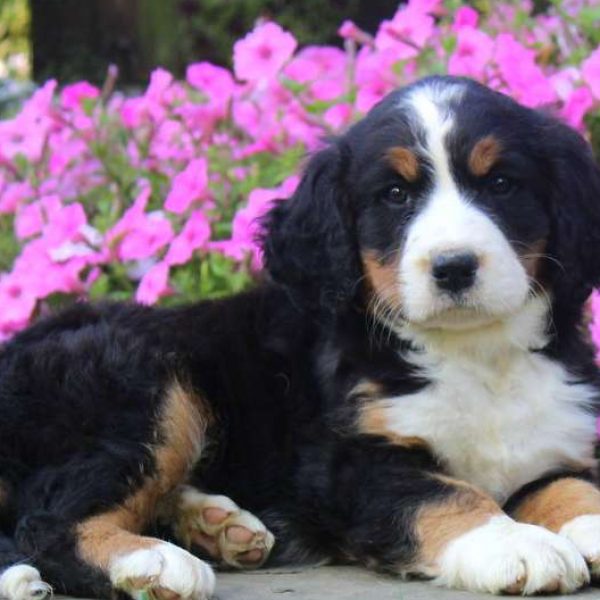
-
Activity Level:
moderate
-
Shedding Level:
moderate
-
Grooming Level:
moderate
-
Trainability:
high
-
Good for Novice Owners:
high
-
Adaptability:
high
-
Kid/Pet Friendly:
often
-
Prey Drive:
high
-
Watchdog:
aware
- Average Size: Medium
- Average Lifespan: 8-14 years
Bernese Springer Spaniel Dog Breed Information
Overview
Temperament
Adaptability
Health
Owner Experience
Grooming
Activity Level
Size
Life Span
Did You Know?
The Bernese Springer Spaniel is a cross between a Bernese Mountain Dog and an English Springer Spaniel. Although a mixed-breed dog can inherit any combination of traits from one or both of the parent breeds, there are some things you can expect in a Bernese Springer Spaniel. These dogs tend to be energetic, playful, friendly, and intelligent. They make great companions for single owners and families.
A Bernese Springer Spaniel is a loyal, loving, and affectionate dog that thrives on attention and affection from their family. They tend to have a sweet, gentle nature and an open, friendly disposition.
They also tend to get along fantastically with children, other pets, and people as long as they are well-socialized. They can have a high prey drive, so they may need some extra socialization with other smaller pets in the household. They tend to do well with pets in the family that they have been raised with.
Bernese Springer Spaniels tend to be highly adaptable dogs. They do well in both apartments and larger homes as long as they get enough exercise and mental stimulation every day. Because they bond closely with their families and thrive on being with them, they do not like to be left alone for long periods of time.
These dogs have a double coat, which means they do well in most climates. As with any dog breed, they are sensitive to heat. They also should only be let off-leash in securely fenced areas, as their high prey drive could lead them to run off in pursuit of something interesting, and they may not notice or listen to recall commands.
The Bernese Springer Spaniel can inherit conditions common to one, both, or neither of their parent breeds. As with any dog breed, there are some potential health concerns to be aware of. In the Bernese Springer Spaniel, these can include hip dysplasia, elbow dysplasia, and eye conditions.
Good breeding practices and the health of the parents make a big difference in Bernese Springer Spaniel puppies. Reputable breeders will regularly screen their dogs to make sure they are not passing preventable issues on to puppies. So, don’t be afraid to ask about the health and genetic history of both parents.
Like their parents, a Bernese Springer Spaniel is a barrel-chested dog breed, which puts them at a higher risk of bloat. Because bloat in dogs can become dangerous and quickly becomes fatal if the stomach flips (i.e., gastric torsion occurs), it’s important to know how to reduce the risk and what symptoms mean that it’s time to get to the emergency vet.
This is a highly trainable dog breed. Bernese Springer Spaniels are eager to please their owners, intelligent, and obedient. This means they pick up on things quickly and also tend to be a good fit for owners of all experience levels. With some of the best dog breeds for first-time owners as parents, the Bernese Springer Spaniel also tends to be a good fit for first-time dog owners.
Even if you don’t need them for help with training, puppy training classes can still be a good idea. They often offer opportunities to socialize a puppy, and can also help strengthen your bond with them, while reinforcing the training you’re working on at home.
A Bernese Springer Spaniel tends to have a thick double coat with a medium-length outer coat. They shed moderately year-round with heavier shedding sessions as the seasons change. Brushing a couple of times a week is usually enough to remove tangles and prevent mats. Increasing to daily brushing during seasonal shedding is generally a good idea. Bathing is on an as-needed basis.
In addition to coat care, you will also need to care for your Bernese Springer Spaniel’s nails, ears, and teeth. Cutting your dog’s nails once or twice monthly is usually enough to keep them from growing too long, but you may need to trim them more often if they grow quickly. Also, checking weekly and carefully cleaning your dog’s ears as needed can help prevent ear infections.
Because many dog owners don’t practice good dental care for dogs, gum disease is one of the most common health issues in dogs. But, it doesn’t have to be that way! Brushing your dog’s teeth or using an enzyme toothpaste every day, in addition to cleanings at the vet when needed, can help prevent painful dental diseases and further complications from them later in life.
Bernese Springer Spaniels are energetic and playful dogs that can range from moderate to high energy. Daily walks, plus some playtime, time to run, and extra activity, are usually sufficient for this dog. But, as long as it’s not too warm outside, they’ll likely be up for more activity if you are.
They’ll just be happy to be doing something with you. These dogs tend to be athletic and versatile, so don’t be afraid to try different activities with them, like swimming with your dog, going on hikes, teaching them to play frisbee, going to the dog park, and more. You could discover a new favorite activity! Just make sure activities stay low-impact until puppies finish growing to avoid damage to developing bones and joints.
Fully-grown Bernese Springer Spaniels can stand 18-28 inches tall and weigh 40-110 pounds. Although the goal is to have a dog that is around 20 inches tall and weighs around 50 pounds, there is always the potential that they will take after their Berner parent and be a bit larger. It’s not a guarantee, but meeting the mother in person can give you an idea of what size to expect in a Bernese Springer Spaniel.
A Bernese Springer Spaniel generally lives for 8-14 years on average.
English Springer Spaniels have an urge to chase. As hunting dogs, they are used to flush out, or “spring,” game in the field, but they can also point and retrieve. Because of this, Bernese Springers also tend to have an urge to chase. They might carry things in their mouths, or they might be dogs that bring things to you. You might even see them point once in a while during play.






